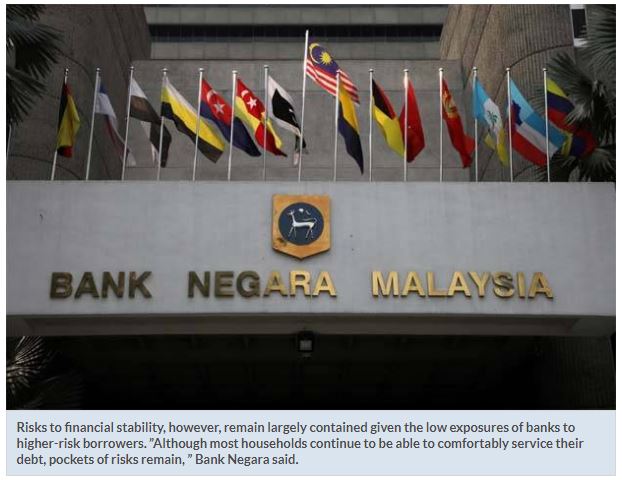Household debt remains an issue in Malaysia
PETALING JAYA: Expensive property prices continue to put a heavy burden on the lower income group, placing homeowners with high mortgages among the most vulnerable to potential financial shocks.
Bank Negara, in its half-year financial stability review, said while the share of household debt held by borrowers earning less than RM3,000 per month has declined, the leverage of these borrowers had, however, risen steadily.
This was driven by housing loans that have been made more accessible under various loan assistance schemes introduced in recent years.
“This borrower group remains susceptible to financial distress given their limited financial buffers to weather potential shocks, ” Bank Negara said in the mid-year report released yesterday.
Risks to financial stability, however, remain largely contained given the low exposures of banks to higher-risk borrowers.
”Although most households continue to be able to comfortably service their debt, pockets of risks remain, ” Bank Negara said.
The overall household debt levels continued to rise, with residential property loans remaining as the key driver of debt growth. Bank Negara said overall household debt level remained elevated at 82.2% of gross domestic product.
“Aggregate household financial assets continued to expand at a faster pace than that of debt, sustaining household financial asset buffers at 2.2 times of debt.
Additionally, Bank Negara said house prices continued to expand at a more moderate pace amid sustained demand for affordable properties.
“Total unsold units have however risen further, mainly driven by properties priced above the maximum affordable house prices in individual states. This contrasts with a strong recovery in housing transactions for units priced below RM500,000 recorded in the first quarter.
“While the mismatch between housing supply and demand is likely to take some time to resolve, firm demand for affordable housing is expected to mitigate risks of a sharp and broad-based decline in house prices.”
In the non-residential segment, the central bank said the incoming supply of new office space and shopping complexes remains significantly higher than recent average annual demand.
“This is likely to further compound already elevated levels of vacancy rates for prime office and retail space, and prime retail space per capita in major cities. Banks remained cautious in lending to this segment, with low exposures that continue to be largely performing.”
Bank Negara said domestic financial markets remained orderly despite domestic and external headwinds.
“Strong domestic institutional investors, including financial institutions, have continued to provide an important source of stability to the domestic markets during periods of heavy portfolio outflows. This, in turn, has supported stable domestic funding conditions for businesses and households.
“Active risk management and hedging strategies by banks continued to contain market risk exposures at manageable levels, well within prudent internal loss limits. This in part reflects greater caution observed by banks amid prevailing uncertainties during the first half of 2019.”
Similarly, it said insurance and takaful operators also continued to actively manage their investments in line with their liability structures.
Bank Negara added that the financial sector remained resilient, underpinned by strong capital and liquidity buffers, and sustained profitability.
“Liquidity in the banking system remained sufficient to support domestic financial intermediation, with the Liquidity Coverage Ratio of the banking system strengthening further over the past six months.
“Based on data gathered during the observation period, most banks are well-positioned to meet these requirements, ” it said, adding that banks, insurers and takaful operators also maintained strong capitalisation levels that were well above the regulatory minimum and higher than internal target capital levels.
It said this is further underpinned by strong buffers against potential losses in line with more forward-looking financial reporting standards and regulatory requirements.
“In the insurance sector, regulatory reforms are supporting improvements in persistency and pricing, which in turn will sustain longer-term performance.”
Bank Negara said stress tests conducted affirmed the resilience of the Malaysian financial system to severe macroeconomic and financial strains, with financial institutions maintaining capital buffers in excess of regulatory minima even under adverse simulated shocks.
“Moving forward, the bank remains vigilant to external and domestic developments which may pose risks to domestic financial stability, including weaker global growth prospects amid increased volatility in capital flows, the elevated level of household debt, soft property market conditions and operational disruptions from increasing cyber-threats.”
Source: https://www.thestar.com.my/business/business-news/2019/09/19/household-debt-remains-an-issue-in-malaysia#H1SGDkkpv6ldUbF7.99


 Thailand
Thailand




